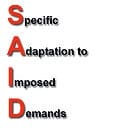Welcome back to the beginning an exercise program series! Today, we are discussing the dreaded plateaus. The best way to avoid a plateau is to make sure you do not hit one! We do this by varying your exercise parameters. We use the SAID principle, which stands for “Specific Adaptations to Imposed Demand.” What that means in English, is we are going to keep changing the demands a muscle has to go through in order to prevent it from reaching that plateau state.
The frequency with which you change these variables can be weekly, once every two weeks, monthly, or every 2-3 months. Any longer than 2-3 months and you are likely to hit a plateau. For some people this may actually be shorter. I would recommend at least monthly changes.
So what are the variables you can manipulate using the SAID principle?
Sequence – Large muscle groups first or small? The answer is it depends on your current goals. If your goals are to gain overall strength or size, then working your small muscle groups first may fatigue your stabilizing muscles and prevent you from lifting maximal loads for the larger groups. However, if you are just starting out, it is recommended to start with the smaller muscle groups so that you build stability and control.
Small muscle groups: Deltoids, rotator cuff, forearms, calves, biceps, triceps
Large muscle groups: Glutes, quads, hamstrings, pectorals, lats, traps.
*Lists are not all inclusive*
Volume – This is a product of (sets x repetitions x weight). Multiply the number of sets you do, by the number of repetitions, and then by the weight. By making sure you are increasing the volume during periods of growth (training for competition) and decreasing the total volume during periods of rest (post competition recovery routines) you can ensure that you are imposing safe demands on your muscles.
Intensity – This generally refers to weight. It is recommended that for small muscle groups you only increase by about 2.5% per week. For larger muscle groups you can safely increase by about 5% per week. This generally translates into 2.5-5 pounds for small upper extremity muscles, 5-10 pounds for large upper extremity muscles, 5-10 pounds for small lower extremity muscles, and 10-15 pounds for large lower extremity muscles.
Rest intervals – Changing your resting period can completely shock your muscles in a whole new way. Generally it has been practiced that if you are performing with maximal loads you rest 2-3 minutes between exercises. If you are not practicing with maximal loads, resting periods may vary anywhere between 30s-2min. Changing this up every once in a while is an easy way to ensure your routine does not get stale.
Type of exercise – You can change your routine to focus on a different type of contraction as well as progressing to more complex exercises. You can focus on powerful concentric reactions for explosive power, you can focus on the eccentric portion which has been shown to increase hypertrophy, or you can focus on isometric contractions if you’re trying to get stronger within a certain range of motion.
There you have it! These are the principles that you can manipulate. These explanations barely scratched the surface on many of the manipulations. However, referring back to the SAID principle is a great way to get you on your way and continue to improve your performance.
In our next episode we will discuss different types of injury and how to avoid becoming injured.



